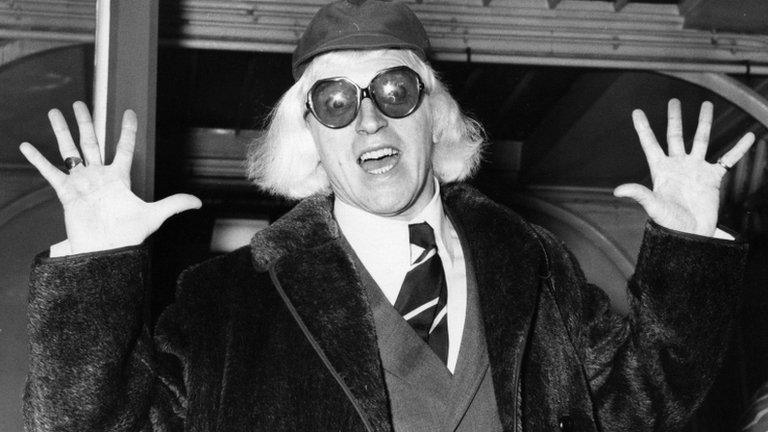Profile: Jimmy Savile
- Published
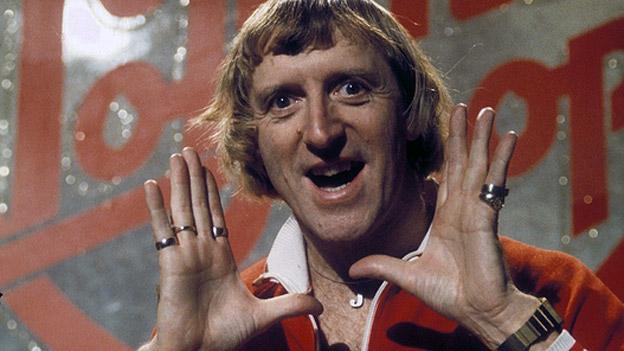
Savile 'used his celebrity status as a powerful tool to coerce or control' his victims, a report concluded
In his lifetime, millions knew Jimmy Savile as an eccentric TV personality. To some, he was Saint Jimmy, who raised £40m for charity. But it has transpired that he was also one of the UK's most prolific sexual predators.
Savile was one of Britain's biggest stars, a larger-than-life character who was known for tea-time TV favourites like Top of the Pops and Jim'll Fix It as well as stints on BBC Radio 1.
At the same time, it later came to light, he was exploiting his status to prey on hundreds of people - girls and boys, men and women, but mostly vulnerable young females.
He assaulted and raped them in television dressing rooms, hospitals, schools, children's homes and his caravan.
The scale of Savile's crimes was "to the best of our knowledge unprecedented in the UK", according to a report into his activities titled Giving Victims A Voice, which was published in 2013.
The abuse was thought to have begun in the mid-1940s, when he was in his late teens or early twenties, and lasted until 2009, two years before his death.
"It is now clear that Savile was hiding in plain sight and using his celebrity status and fund-raising activity to gain uncontrolled access to vulnerable people across six decades," the Giving Victims A Voice report concluded.
He was, the report said, "a mainly opportunistic individual who used his celebrity status as a powerful tool to coerce or control them, preying on the vulnerable or star-struck for his sexual gratification".
Another report, The Dame Janet Smith review, identified 72 victims of Savile in connection with his work at the BBC, including eight who were raped. Eleven of his victims were younger than 12 years old.
It found thatthe BBC missed opportunities to stop "monstrous" abuse by the presenter and DJ because of a "culture of fear".
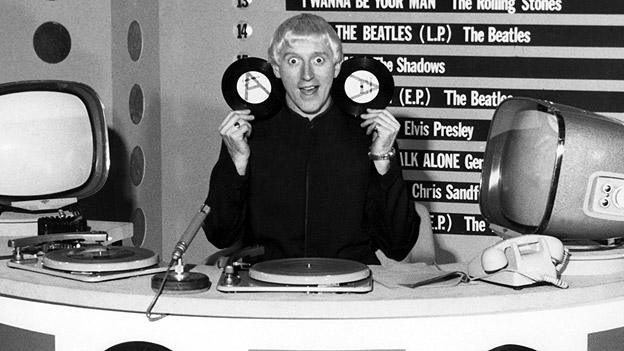
Savile hosted the first edition of Top of the Pops in 1964

Savile, pictured in 1965, first rose to fame as a dance hall DJ and manager
Savile once famously claimed he had no emotions.
"That would make me bad news for a psychiatrist or a psychologist because there's nothing to find," he told Dr Anthony Clare in BBC Radio's In the Psychiatrist's Chair in 1991. "What you see is what there is."
But that was the carefully constructed Savile myth. It ensured very few people ever really got close to him, or knew the truth about what made him tick.
The public persona portrayed him as eccentric and flamboyant, but essentially straightforward and good-natured.
The mask rarely slipped while he was alive, and it helped him deflect accusations of anything more sinister. He would attract speculation because he was odd, he would say - but that was all he was.
"It's a nice thing that I have nothing to hide from people," he told a documentary titled The World of Jimmy Savile OBE in 1972.
"They ask me, are you queer? I say no, but if I felt that way I would have been. They ask me, why don't you get married? I say, well I've never felt the need.
"I've got nothing to hide from people, and when you come to think about it I lead a dead simple sort of life, which is OK, and definitely enough for me."
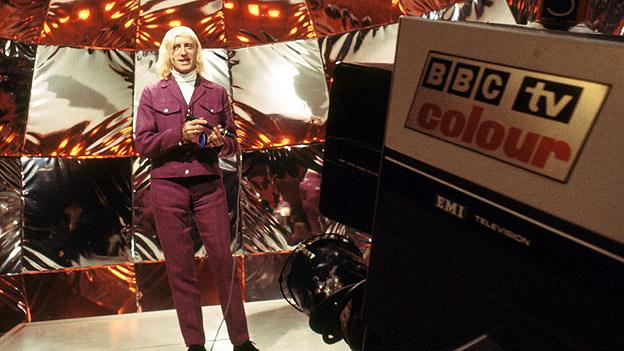
With flamboyant dress sense and persona, Savile cultivated an image as a larger-than-life celebrity
But in one rare moment of candour, he was asked by the interviewer Louis Theroux in 2000 why he had said he had no emotions.
"'Cause it's easier," he replied. "You say you've got loads and then you've got to explain them for two hours. The truth is that I'm very good at masking them."
Savile, one of seven children and the son of a bookmakers' clerk, had survived serious spinal injuries while working in a coal mine as a teenager before becoming a dance hall DJ and manager after World War Two.
His clubs included Mecca Locarno club in Leeds in the early 1960s. Post-war austerity was being blown away and Savile claimed to be the first person to DJ with two turntables so there were no breaks between records.
Bouncer Dennis Lemmon later recalled how Savile arrived at the club in a bad mood one day. A colleague told Mr Lemmon that Savile was due in court the following day after "messing about with a couple of girls".
When Mr Lemmon later asked how the case had turned out, his colleague told him: "It never got to court - they dropped the charges."
"I said 'How the hell did he wangle that one?'" Mr Lemmon continued. "He said 'He did what he did last time - he paid them off.'"
So how did he get away with it? "He was a very powerful man, wasn't he?" Mr Lemmon replied. "A very powerful man with a lot of influence."
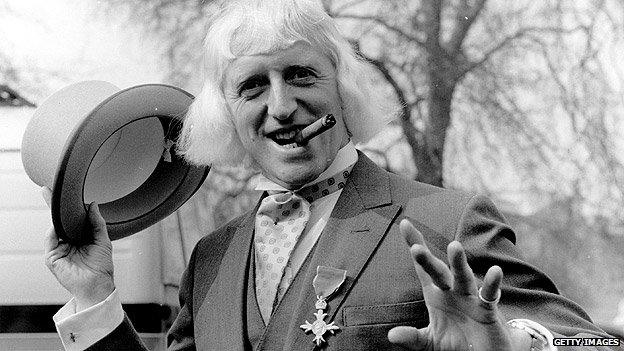
He was appointed OBE for services to charity and broadcasting in 1971

He ran marathons in aid of Stoke Mandeville Hospital
Even at the start of his career, his forceful personality was fully formed and he claimed to have the muscle to back it up.
Savile told Louis Theroux that during his club days, he "invented zero tolerance" and was "judge, jury and executioner" when he locked troublemakers in the club basement.
The aura remained as Savile became more famous and influential. He later cultivated friendships with Prime Minister Margaret Thatcher and King Charles.
It is not difficult to see how a young victim could have believed that his or her word may have counted for less than his.
'Open secret'
After the clubs, the tracksuit-wearing, platinum-haired showman went on to become a familiar presence, weighed down with jewellery and with cigar in hand.
Figures from the music industry and TV world have said they heard rumours about Savile's behaviour.
Roger Holt, a former record plugger who would visit the Radio 1 offices every week in the 1960s, said Savile's predilection for young girls was "an open secret".
"I heard through his office, just in conversation, 'Jimmy's at it again,'" he said. "He used to travel the country with his colleagues at the BBC [who would say] 'Oh he gets these young girls in his Rolls or the caravan when he was travelling around.'
"They'd just say 'Oh he's after these young girls.' It was an open secret in the record industry."
Savile would not socialise like other DJs, Mr Holt recalled.
"He was just a very strange person. You couldn't really have a conversation with him. I used to see him at Top of the Pops and didn't talk to him unless I had to go to his dressing room.
"When I had to go to his dressing room the last time I was there, there weren't any young girls in there - there were a lot of his mates who I thought were as weird as he was. There was definitely a clique in that dressing room."
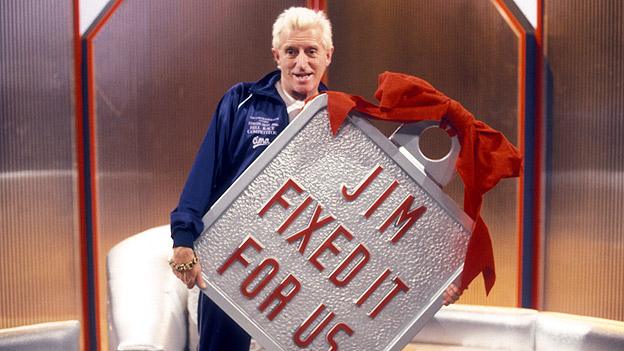
Jim'll Fix It ran between 1975 and '94
Some suspicions centred on Savile's activities in the caravan he took on the road with a Radio 1 show called Savile's Travels.
In 1973, Radio 1 controller Douglas Muggeridge asked the station's press officer Rodney Collins to check whether any newspapers were planning to print rumours about his exploits.
"There were allegations that there were girls, under-age girls involved, maybe, in the caravan," Mr Collins told the BBC.
He reported back that the papers had "heard these allegations" but were unwilling to print them "whether they were true or not" because Savile did a lot for charity and was "perceived as a very popular man".
Savile persuaded the tabloids not to run stories by telling them they would be responsible for the end of his charity fund-raising.
Savile was said to have raised £40m for charities and it was an effective form of emotional blackmail.
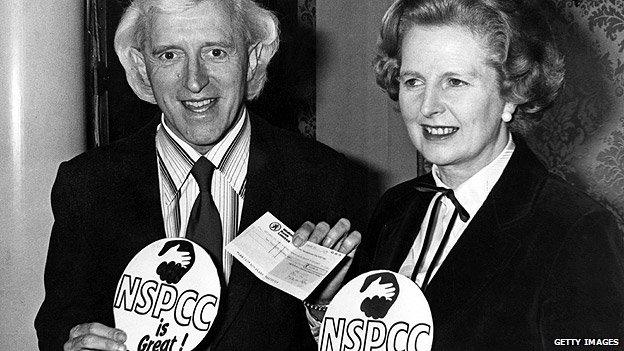
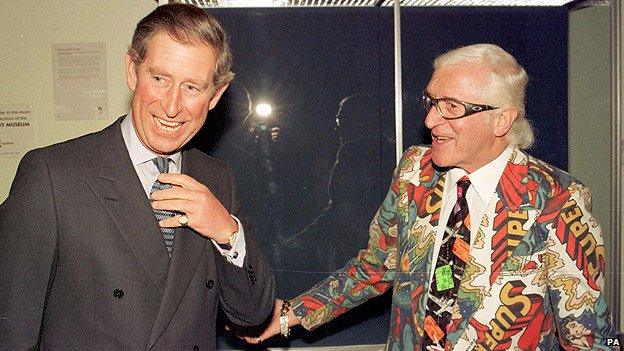
His charitable activities helped him gain friends in high places
His fund-raising activities also gave him a way to get into hospitals, schools and the corridors of power.
He had a bedroom at Stoke Mandeville hospital in Buckinghamshire, where his now-defunct charitable trust was based, as well as an office and living quarters at Broadmoor psychiatric hospital in Berkshire.
In 1988, he was even appointed by the Department of Health as the head of a taskforce overseeing Broadmoor.
Eleven allegations of sexual abuse at Broadmoor were reported to a review that was published in June 2014, but this is thought to be an underestimate.
The review also recounted how he watched and made inappropriate comments when female patients stripped and showered naked in front of staff.
'Unwholesome' interests
Dr Chandra Ghosh, a former consultant psychiatrist at Broadmoor, told the BBC's Panorama that the victims were highly vulnerable.
"These were people that nobody believed," she said. "So if they had in fact turned around and said that he had abused them or raped them, nobody would have believed them."
Savile was also a regular visitor to Leeds General Infirmary, where at least 60 people have come forward to say they were abused. They were aged between five and 75 at the time.
A total of 44 reports into Savile's activities in relation to specific hospitals and hospice premises have also been published.
Stoke Mandeville Hospital was one of those concerned and a report published in February 2015 found Savile had full and unsupervised access to all areas of the hospital for more than 20 years.
It described Savile as an "opportunistic predator" who abused more than 60 victims between 1968-92.
Dr Sue Proctor, who chaired an inquiry into Savile's actions at Leeds General Infirmary, said the star also had an "unwholesome interest in the dead".
It is alleged he posed for photographs and performed sex acts on corpses in the hospital mortuary. She also referred to Savile's claims that large rings he wore were "made from the glass eyes of dead bodies at the mortuary".
'Very naive'
For Savile's friends and acquaintances who had no inkling of his darker side and only remembered his acts of charity, all this has been hard to come to terms with.
Roger Ordish, producer of Jim'll Fix It, which ran between 1975 and '94, said he never suspected any wrongdoing.
When Savile stayed at the Ordish family home one night, they put him in a bedroom next to their 14-year-old daughter. "We, in our innocence, had no idea," Roger Ordish's wife Susie said, speaking in October 2012.
Mrs Ordish said she thought Savile treated every woman the same way - "a very unsophisticated, naive, clumsy way".
"He would kiss every woman's hand. He thought he was being gallant. It wasn't gallant. It wasn't seedy. It was just very naive," she said.
"Because of his clumsiness with women, which was not in the least sexual, I thought he was one of those asexual people."
One of Savile's tactics for keeping his friends in the dark about his private life was to keep them apart.
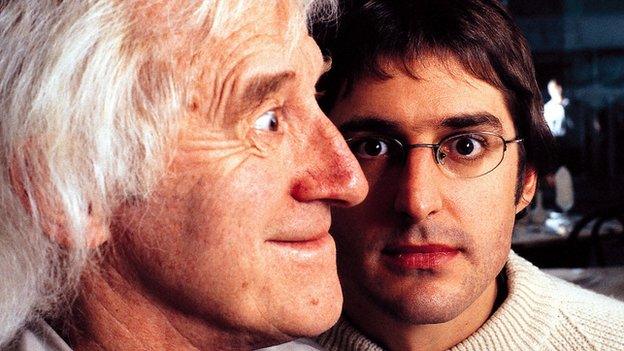
Film-maker Louis Theroux gained some insight into the real Jimmy Savile in his 2000 documentary
Many fellow DJs, with whom he worked on BBC Radio 1 for decades, admitted they barely knew the man at all. But he had a separate set of friends in his home city of Leeds, with whom he would go running or have weekly meals in the Flying Pizza restaurant.
As well as Leeds, he had homes in Scarborough, London, Scotland and Bournemouth and had different groups of friends in different places. They were his "teams", he called them.
In Scarborough, Louis Theroux was let into the flat where Savile's mother had lived, and discovered Savile's continuing attachment to her, 27 years after her death.
Savile kept clothes belonging to his mother - whom he dubbed The Duchess - in her wardrobe, just as they had been when she had died.
After that documentary, the view many held of Savile shifted from odd to creepy.
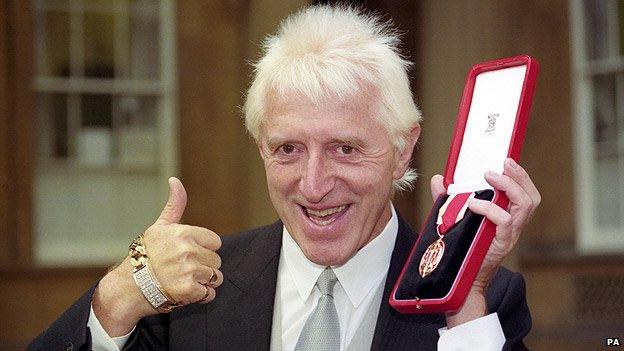
Savile was proud of the knighthood he received in 1990
One key element of the public Savile persona was that, despite hosting children's TV shows, he hated children.
Theroux again managed to get Savile to open up when he asked the star why he insisted that he hated youngsters.
"We live in a very funny world and it's easier for me as a single man to say I don't like children because that puts a lot of salacious tabloid people off the hunt," he replied.
Was that because such a reply would stop questions about whether or not he was a paedophile, Theroux asked?
"How do they know whether I am or not?" Savile said. "How does anybody know whether I am?
"Nobody knows whether I am or not. I know I'm not, and I can tell you from experience that the easy way of doing it, when they say, all them children on Jim'll Fix It, is to say, yeah, I hate them.
"That's my policy. That's the way it goes. And it's worked a dream. A dream."
Police forces did have chances to take Savile to court while he was alive - but no charges were ever brought.
Legal threats
In 2009, the Crown Prosecution Service looked at four allegations dating back to 1970, but decided not to pursue a case because the victims would not support police action.
Savile was interviewed under caution and said the allegations had been invented by the complainants, who he claimed were after money.
He threatened to take legal action against the police and mentioned that he had sued five newspapers in the past.
Savile was also named during a 2008 police investigation into abuse at Haut de Garenne children's home in Jersey.
But the truth did not come out until after his death in 2011.
"As a nation, at that time we held Savile in our affection as a somewhat eccentric national treasure with a strong commitment to charitable causes," Health Secretary Jeremy Hunt said in June 2014.
"In reality he was a sickening and prolific sexual abuser who repeatedly exploited the trust of a nation for his own vile purposes."
Related topics
- Published10 October 2023
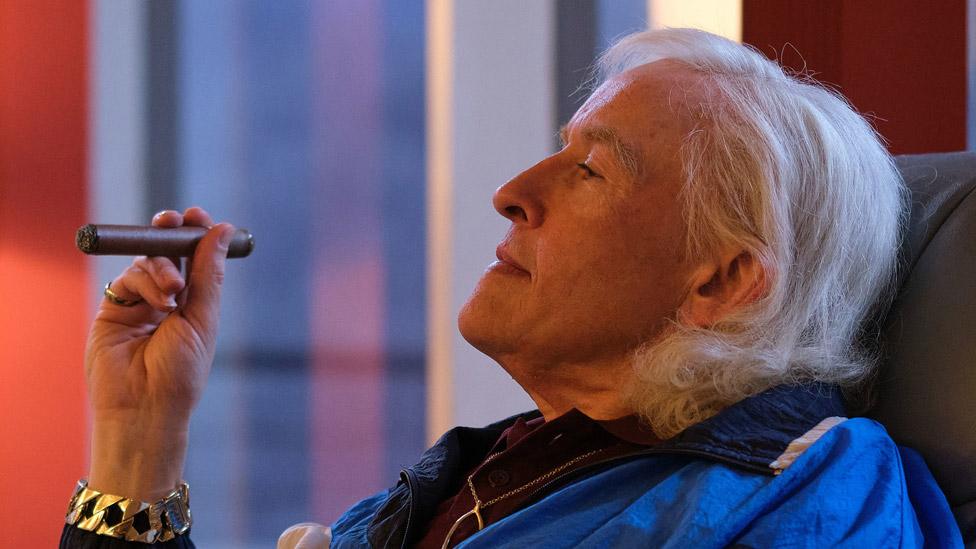
- Published7 October 2023

- Published11 January 2013
